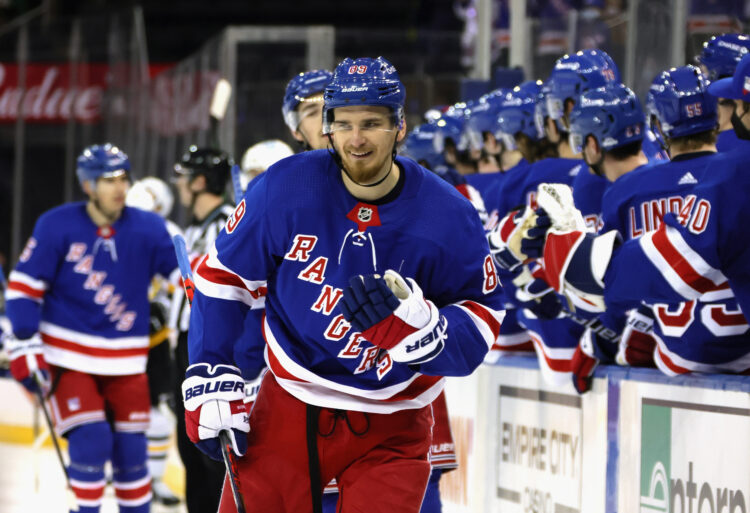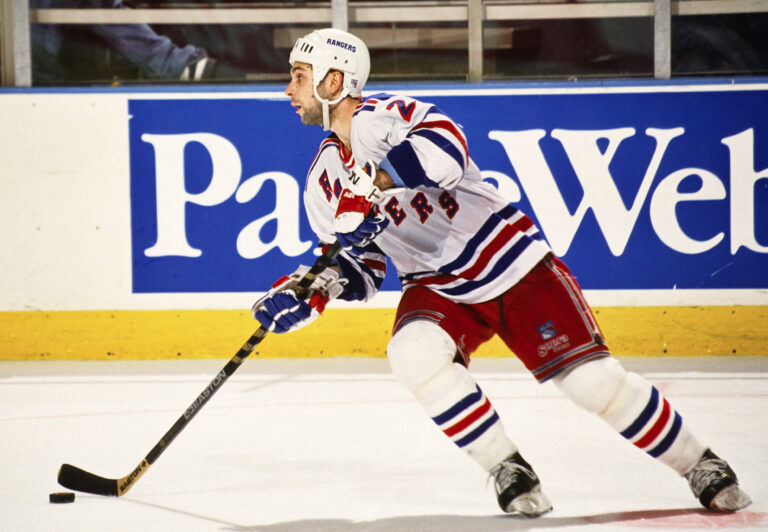New York Rangers worst trades in past 50 years, including Luc Robitaille twice

It’s every NHL general manager’s worst nightmare: The trade you thought would be a key to a rebuild or a big step into championship contention blows up on you. Instead of one step forward, your team takes three steps back — and you face the possibility of stepping from the GM’s office to the unemployment line.
The New York Rangers haven’t been immune to the kind of trade that leaves fans scratching their heads and wondering what their GM was thinking when he made the deal. Sometimes it’s a player they acquired who didn’t produce; other times it’s one whose career took off after leaving New York. And sometimes it’s both.
Either way, they’re the kind of move that fans can’t forget — no matter how hard they try.
Related: Rangers best trades in past 50 years, including Mark Messier
Worst Rangers trades in past 50 years
Here’s a look at the seven worst trades the Rangers have made during the past five decades.
7. Singing the Blues on Buch

The Trade: Rangers acquired forward Sammy Blais and a second-round pick in the 2022 NHL Draft from the St. Louis Blues for forward Pavel Buchnevich.
Date: July 23, 2021
Why it mattered: Buchnevich, a third-round pick in the 2013 draft, arrived in New York three years later and took a slow but steady path toward NHL success. He was coming off his best NHL season with 20 goals and 48 points in 51 games during the COVID-shortened 2020-21 season — becoming the player the Rangers had been waiting for. But as a restricted free agent that summer and with unrestricted free agency a year away, “Buch” was going to cost the cap-strapped Rangers more money than they could commit.
Stuck between a rock and a hard place, Chris Drury, who’d just been named general manager, traded Buchnevich to the Blues for Blais, a bottom-six forward, and a draft pick.
Unfortunately for the Rangers, each player continued on the development track he’d been on before the trade.
For Buchnevich, it meant that he became a reliable top-line point producer, one who’s scored 73 goals and averaged nearly a point per game in his three seasons with the Blues. At 29, there’s no reason he shouldn’t continue to put up solid point totals for the foreseeable future.
Blais had been a role player on the Blues’ 2019 Cup-winning team, but never developed into anything more than that and was plagued by injuries during his time with the Rangers. He wound up going back to St. Louis ahead of the 2023 trade deadline as part of the deal that brought Vladimir Tarasenko to New York.
6. Left out

The Trade: Rangers acquired left wing Kevin Stevens from the Los Angeles Kings for left wing Luc Robitaille.
Date: Aug. 28, 1997
Why it mattered: Robitaille is among the all-time greatest scorers in NHL history, but not because of his two seasons with the Rangers. He scored at least 40 goals with the Los Angeles Kings in all eight of his non-lockout NHL seasons when the Rangers acquired him in the summer of 1995, and GM Neil Smith was counting on “Lucky Luc” to give the Rangers an offensive boost on left wing.
But it didn’t happen. After two seasons that saw Robitaille fail to score even 25 goals, the Rangers decided to cut their losses and send him back to L.A. Unfortunately for Smith and the Rangers, the return was veteran left wing Kevin Stevens, a scoring terror with the Pittsburgh Penguins in the early 1990s whose offensive numbers had dropped sharply.
Robitaille turned out to be going through a mid-career lull, but Stevens’ issues were more serious, on and off the ice. His 23 goals and 43 points with the Rangers in 1998-99 were his best single-season numbers from 1994 through the end of his career in 2002. A big reason was that the pain pills he took to cope with a serious head injury sustained in the 1993 playoffs turned into an addiction and a long downslide that ultimately led to his arrest on federal drug charges in 2016 (he’s sober today and helps those dealing with addictions).
Robitaille’s scoring touch returned in Los Angeles, where he scored at least 30 goals three more times — then did it again while helping the Detroit Red Wings win the Stanley Cup in 2002. He’s a member of the Hockey Hall of Fame and was named one of the 100 Greatest NHL Players in 2017.
5. Chasing past glories didn’t work
The Trade: Rangers acquired forwards Jari Kurri and Shane Churla and defenseman Marty McSorley from the Los Angeles Kings for center Ray Ferraro, forwards Ian Laperriere and Nathan Lafayette, and defenseman Mattias Norstrom.
Date: March 14, 1996
Why it mattered: Smith’s love for ex-Edmonton Oilers didn’t end when the Rangers won the Stanley Cup in 1994. Unfortunately for him, the same formula didn’t work two years later.
Smith added to his collection of former Oilers ahead of the 1996 trade deadline by bringing in Kurri and McSorley, who had previously been dealt by the Oilers to the Los Angeles Kings, as well as enforcer Shane Churla. The deal cost the Rangers three young players and Ferraro, a veteran center who had signed with the Rangers as a free agent in the summer of 1995.
It turned out to be a complete failure, with the three newcomers playing a combined total of 78 games with the Rangers. Kurri and McSorley did almost nothing in New York and were gone before the next season began. Churla played the final 55 games of his 11-season NHL career with the Rangers, managing all of one assist.
Even worse for the Rangers was the success of two of the young players they traded away.
Norstrom became a top-four defenseman who played 11 solid seasons in L.A. and was Kings captain. Laperriere became one of the League’s most effective agitators and played 13 more seasons in the League, eight with the Kings.
Add in the 110 goals scored by Ferraro after the trade, giving him 408 for his career, and this goes down as the kind of trade teams have nightmares about making.
4. A Question of style

The Trade: Rangers acquired left wing Luc Robitaille and defenseman Ulf Samuelsson from the Pittsburgh Penguins for defenseman Sergei Zubov and center Petr Nedved.
Date: Aug. 31, 1995
Why it mattered: Zubov was a steal when the Rangers grabbed him in the fifth round of the 1990 NHL Draft with the compensation pick they received when the Quebec Nordiques signed Guy Lafleur. He led the team in scoring during their 1994 Cup run and had 36 points in 38 games in 1994-95. But the young Russian looked physically overwhelmed in the playoffs by the Philadelphia Flyers’ “Legion of Doom,” so Smith decided to make some changes.
He got the size and nastiness he wanted on the blue line by sending Zubov to the Pittsburgh Penguins along with Nedved for Robitaille and Samuelsson, a defenseman who never saw an opponent he didn’t want to bash.
Unfortunately for Smith, the NHL was shifting away from big, slow defensemen like Samuelsson, who contributed little offensively in his nearly four seasons with New York. The new model was skilled players such as Zubov, who was traded by the Penguins to the Dallas Stars the following summer and went on to a Hall of Fame career that was built on his ability to move the puck and generate offense.
To make matters worse, Robitaille looked little like the player who’d had eight 40-goal seasons with the Kings before a lockout-shortened 23-goal showing in Pittsburgh in 1994-95. In the summer of 1997, the Rangers sent him back to L.A. — and his scoring touch returned. Talk about a trade where nothing went right!
3. A New Year’s dud
The Trade: Rangers acquired center Bobby Carpenter and a second-round pick in the 1989 NHL Draft from the Washington Capitals for center Mike Ridley and forwards Kelly Miller and Bob Crawford.
Date: Jan. 1, 1987
Why it mattered: Phil Esposito was one of the greatest goal-scorers in NHL history, so it’s not surprising that a young player who could put the puck in the net would pique his interest after he became the Rangers general manager in 1986. Carpenter, the first player to jump from high school to the NHL, had the first 50-goal season by a U.S.-born player when he scored 53 times for Washington in 1984-85. His offensive numbers were down in 1985-86 and again in the first half of 1986-87, but he was still just 23 when the impulsive Esposito started 1987 by bringing him to New York. It didn’t look like the price was unduly high. Though Ridley was coming off a 65-point rookie season in 1985-86 and had 36 points in 38 games in year two, he had no pedigree as an undrafted center from a Canadian college. Miller, a ninth-round pick in 1982, didn’t look like he’d be anything special, and Crawford’s 36-goal season with the Hartford Whalers in 1983-84 looked more and more like a fluke.
However, whatever offensive skills Carpenter owned didn’t make the trip. After five straight seasons of at least 27 goals and 56 points, Carpenter couldn’t find the net with radar after coming to the Big Apple. He managed all of two goals and 10 points in 28 games with the Rangers before Esposito, in another bout of impulsiveness, sent him to Los Angeles for future Hall of Famer Marcel Dionne, who lasted two seasons before retiring.
Carpenter went on to an 18-year career that saw him evolve into a solid checking center who helped the New Jersey Devils win the Stanley Cup in 1995, though he never showed the kind of scoring touch that had attracted Esposito. To add insult to injury, Ridley became one of the League’s best two-way centers during the next decade, finishing with 10 seasons of 20-plus goals, and Miller grew into a reliable middle-six forward. The Rangers paid a huge price for Espo’s impulsiveness.
2. M is for Miss

The Trade: The Rangers acquired centers Brett Howden and Vladislav Namestnikov, defenseman Libor Hajek, a first-round pick in the 2018 NHL Draft and a second-round pick in the 2019 draft from the Tampa Bay Lightning for defenseman Ryan McDonagh and center JT Miller.
Date: Feb. 26, 2018
Why it mattered: Nine years after the Rangers got McDonagh in one of the best trades in team history, they sent the defenseman to the Lightning in one of the worst.
McDonagh’s terrific two-way play was a big reason the Rangers were among the best NHL teams for much of the 2010s. But by 2017-18, things were falling apart — and GM Jeff Gorton was in rebuilding mode, so he sent McDonagh and center JT Miller, a talented 2011 first-round pick who never quite seemed to fit in New York, to the Tampa Bay Lightning, who had beaten the Rangers in Game 7 of the 2015 Eastern Conference Final.
It looked like Gorton had gotten quite a haul. In addition to the draft choices, Howden was a 2016 first-round pick, Hajek was a highly regarded young defenseman and Namestnikov had already scored 20 goals in 62 games for the Lightning that season.
Instead, the deal turned into a disaster. McDonagh played a key role in helping the Lightning win the Stanley Cup in 2020 and 2021, then helped them oust the Rangers in the 2022 Eastern Conference Final. He’s still an effective defenseman in his mid-30s. Even worse, Miller has blossomed into a 100-point scorer with the Vancouver Canucks, who acquired him from the Lightning in 2019. Meanwhile, none of the players or picks the Rangers received has made any significant impact in the NHL.
The big swing and miss helped turn Gorton into a former Rangers GM by 2021.
1. Hodge Podge
The Trade: Rangers acquired forward Ken Hodge from the Boston Bruins for forward Rick Middleton.
Date: May 26, 1976
Why it mattered: John Ferguson’s first trade as general manager was one older Rangers fans are still trying to forget.
The scene had been set six months earlier, when the Rangers and Bruins made perhaps the biggest trade in NHL history at that time, with the Rangers getting Esposito, still a high-scoring center, and defenseman Carol Vadnais from the Bruins for center Jean Ratelle and defensemen Brad Park and Joe Zanussi. Espo’s scoring touch diminished in New York, and after the season he went to Ferguson, who got the GM job in January 1976 after Emile Francis was fired, and pushed for the acquisition of Ken Hodge, his longtime right wing.
Ferguson, who was trying to remake the Rangers, was willing to help Espo by bringing in his old linemate. The Bruins wanted 23-year-old Rick Middleton, who had scored 22 and 24 goals in his first two NHL seasons. “Nifty” was talented but flashy — not Ferguson’s kind of player. Hodge, nine years older, was.
To say the trade was a disaster would be putting it kindly. Hodge managed 21 goals and 62 points in his only full season with the Rangers. By the middle of 1977-78, he was in the American Hockey League and never played in the NHL again.
Middleton took a couple of seasons to find a fit in Boston, but he began a streak of seven straight 30-goal seasons in 1978-79 and scored 40 or more from 1979-80 through 1983-84. He helped the Bruins reach the Stanley Cup Final three times (they lost all three), had two 100-point seasons and finished his career with 448 goals and 998 points in 1,005 games. The Bruins retired his number in 2019.
The Rangers traded Middleton’s future for Hodge’s past. It’s a formula that almost never works; in this case, it was a disaster.
More About:New York Rangers Analysis
